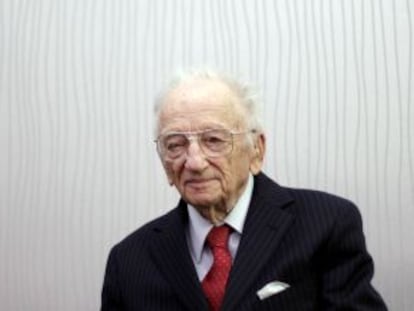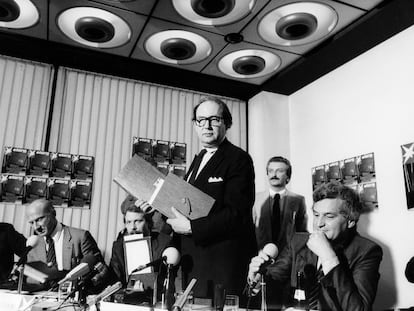How the world has appropriated Anne Frank
The diarist’s father, Otto, was the first censor of her work and a graphic novel that alludes to her explicit anatomical descriptions has been banned in some Florida high schools


At some point in the spring of 1944, Anne Frank was listening to the radio in the secret annex, the tiny and suffocating dwelling hidden behind a bookcase at Prinsengracht 263 in Amsterdam where her family and four others hid out during the Holocaust, when she heard a speech by the Dutch Minister of Education in exile in which he stated that, after the war, everything written during the Nazi occupation would be published in order to “document the suffering of the Dutch people,” including diaries. Convinced that the record she had kept would help her fulfill her dream (“I shall not remain insignificant, I shall work in the world and for mankind!” she wrote at the time), she began to keep a parallel diary, in which she made adjustments to some paragraphs and removed others. In the meantime, she continued to write the famous original, without suspecting to what extent it would be “infantilized, Americanized, homogenized, sentimentalized; falsified, kitschified, and, in fact, blatantly and arrogantly denied,” as the novelist and essayist Cynthia Ozick notes.
A recent example of this came two weeks ago when the Vero Beach high school in Indian River County, Florida, banned a graphic novel based on the diary — adapted by filmmaker Ari Folman, the son of survivors of the Nazi genocide, and cartoonist David Polonsky, in 2017 — on the grounds that it “whitewashed the Holocaust.” In reality, what Moms For Liberty — the association that pushed for the censorship of the book, which later spread to the rest of the high schools in the county — apparently didn’t like was the “explicitly sexual” content of the work in question, which contains a scene in which Anne Frank asks a friend to undress in front of her so she can look at her, saying she will do likewise. Contemplating the nude statues in the history books has begun to unsettle her, and she wants to see a real body other than her own. When it was discovered that in the original manuscript — edited by her father, Otto Frank, the first and greatest appropriator — the teenager included explicit anatomical descriptions of her own clitoris, which did not come to light until the scholar Mirjam Pressler rescued them, the affront is even greater.
Ozick takes inventory of such appropriations and distortions in her 1997 essay Who Owns Anne Frank?, a compendium of passionate and essential reading that begins with a vision of the kind of writer (and activist) Anne Frank could have been today had she not died of typhus in the Bergen-Belsen concentration camp in 1945. A committed woman, whose career “would be closer to that of Nadine Gordimer, let us suppose, than to that of Françoise Sagan.” Ozick also focuses on Otto Frank, the first person to manipulate the original text, suppressing firstly what he did not like and anything that would have cast the family in a bad light — including the attacks of rage that the girl experienced when dealing with her mother — and secondly humanity while also infantilizing the terrifying reality of a work that, despite charging against the horror of the world in which it was written, is often reduced to the phrase: “I still believe, in spite of everything, that people are truly good at heart.”
“Otto Frank grew up with a social need to please his environment and not to offend it […] It was more dignified, and safer, to praise than to blame,” wrote Ozick. After all, he had before him “the larger postwar world that the diary had opened to him.” And he knew how to take advantage of it. He even tried to substitute his daughter for an American teenager, a suburban girl named Cara Wilson who was born in California in 1944 and who wrote to him claiming to have identified with Anne’s adolescent frustrations, frivolously comparing herself to Anne. Otto corresponded with her for years, sent her gifts when her children were born, and unabashedly published a compilation of the letters under the title Love, Otto in 1995.
“It is the shamelessness of appropriation,” wrote Ozick, as nothing is comparable to the Holocaust. Part of the blame was laid at the feet of the theatrical version, portraying the “funny, hopeful, happy” Anne that came to Broadway in 1955 — along with endless litigation, documented in Lawrence Graver’s An Obsession with Anne Frank — and which won the Pulitzer Prize and greatly influenced the way the diary was read.
That the first German translator of the text decided to sugarcoat everything that Anne Frank wrote about the Germans — with Otto’s approval — is evidence, for Ozick, of a lack of respect that existed from the very beginning. " A deeply truth-telling work has been turned into an instrument of partial truth, surrogate truth, or anti-truth,” wrote Ozick.
In 2026, Anne Frank’s diary will enter the public domain and the Basel-based Anne Frank Fund will no longer control her legacy. It is likely that unauthorized versions of the diary will then be published, says Martin Schifino, one of its editors in Spain, where Anne Frank: The Collected Works was published last year. What does the collected works include? The original diary and the complete version edited by Mirjam Pressler, “in which she develops a continuous account of versions A and B,” says Schifino. That is to say, the original diary and the one that Anne Frank herself began to edit. There is also previously unpublished material: letters, reflections, photographs, and essays by well-known historians.
But sales of the collected works have been symbolic compared to those of the diary, which has always been “fireproof,” says Schifino.. In June, a new title will be added to the reinterpretation of the myth: My Friend Anne Frank, the memoirs of Hannah Pick-Goslar, her childhood friend who she was reunited with in the concentration camp. It seems hard not to go with the flow and depict Anne Frank in the way in which the world thinks it knows her, “pulling the wool over the eyes of history,” as Ozick puts it. As the writer says, “Almost every hand that has approached the diary with the well-meaning intention of publicizing it has contributed to the subversion of history [...] The pure has been made impure — sometimes in the name of the reverse.” Something to be sold, in the worst sense of the word, from the beginning by her own father and that, subsequently, has been used as opportunistically as desired. And so, “sanctified and indulgent, stripped of darkness,” Anne Frank lives on.
Sign up for our weekly newsletter to get more English-language news coverage from EL PAÍS USA Edition
Tu suscripción se está usando en otro dispositivo
¿Quieres añadir otro usuario a tu suscripción?
Si continúas leyendo en este dispositivo, no se podrá leer en el otro.
FlechaTu suscripción se está usando en otro dispositivo y solo puedes acceder a EL PAÍS desde un dispositivo a la vez.
Si quieres compartir tu cuenta, cambia tu suscripción a la modalidad Premium, así podrás añadir otro usuario. Cada uno accederá con su propia cuenta de email, lo que os permitirá personalizar vuestra experiencia en EL PAÍS.
¿Tienes una suscripción de empresa? Accede aquí para contratar más cuentas.
En el caso de no saber quién está usando tu cuenta, te recomendamos cambiar tu contraseña aquí.
Si decides continuar compartiendo tu cuenta, este mensaje se mostrará en tu dispositivo y en el de la otra persona que está usando tu cuenta de forma indefinida, afectando a tu experiencia de lectura. Puedes consultar aquí los términos y condiciones de la suscripción digital.
More information
Archived In
Últimas noticias
The complicated life of Francesca Albanese: A rising figure in Italy but barred from every bank by Trump’s sanctions
How Japan is trying to avert ‘digital defeat’
Half of Scotland is in the hands of 420 property owners
From digital curfews to blocking apps: How technology experts protect their children online
Most viewed
- Why we lost the habit of sleeping in two segments and how that changed our sense of time
- Trump’s obsession with putting his name on everything is unprecedented in the United States
- Charles Dubouloz, mountaineering star, retires at 36 with a farewell tour inspired by Walter Bonatti
- The Florida Keys tourist paradise is besieged by immigration agents: ‘We’ve never seen anything like this’
- Living in a motorhome due to soaring housing prices in Madrid: ‘I got used to it quickly, but I don’t idealize it’










































